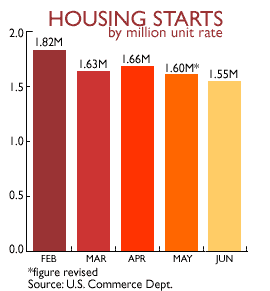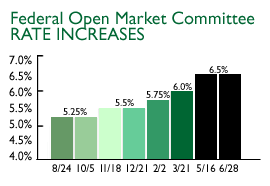|
Housing starts taper off
|
 |
July 20, 2000: 10:04 a.m. ET
June starts slide 2.6% to 1.55M rate, slowest in more than two years
|
NEW YORK (CNNfn) - U.S. builders began construction on new homes at the slowest rate in more than two years in June, while the number of new permits issued to builders fell to the lowest in 2-1/2 years, more signs that the red-hot housing market is feeling the effects of higher interest rates.
 Housing starts fell 2.6 percent last month to a 1.55 million unit annual rate, the Commerce Department said Thursday, below the 1.57 million-unit rate expected by economists and May's revised 1.6 million rate. It was the second straight monthly decline and marked the lowest rate on starts since May 1998. Building permits declined to a 1.51 million annual rate, the lowest since December 1997. Housing starts fell 2.6 percent last month to a 1.55 million unit annual rate, the Commerce Department said Thursday, below the 1.57 million-unit rate expected by economists and May's revised 1.6 million rate. It was the second straight monthly decline and marked the lowest rate on starts since May 1998. Building permits declined to a 1.51 million annual rate, the lowest since December 1997.
The numbers were in line with other recent indicators showing that the U.S. economy, now into its 10th year of uninterrupted expansion, may be starting to respond to the Federal Reserve's series of interest rate increases designed to slow growth and keep inflation in check. Everything from new job creation to manufacturing output to retail sales has tapered off recently, suggesting the Fed's medicine is working.
"Overall, the decline in starts and permits is consistent with the weakness in other economic data in recent months, and suggests that the increase in borrowing costs continues to dampen demand for housing," Ryan Brecht, an economist with Standard & Poor's MMS in San Francisco, said. "You also have an inventory story and a seasonal story, which are factors in the slowdown too."
Demand remains strong
Mortgage rates have risen in tandem with the Fed's rate increases. The Fed has raised its benchmark fed funds rate by almost 2 percentage points since June 1999. Fed Chairman Alan Greenspan speaks to Congress later Thursday about the impact those rate increases are having on economic growth.
 The average rate on a 30-year fixed-rate mortgage was 8.23 percent in June, compared with 7.61 percent a year earlier, according to Freddie Mac, the No. 2 buyer of U.S. mortgages. The average rate on the popular 1-year adjustable mortgages climbed to a nine-year high of 7.27 percent early this month from 6.73 percent at the end of February, according to Freddie Mac. The average rate on a 30-year fixed-rate mortgage was 8.23 percent in June, compared with 7.61 percent a year earlier, according to Freddie Mac, the No. 2 buyer of U.S. mortgages. The average rate on the popular 1-year adjustable mortgages climbed to a nine-year high of 7.27 percent early this month from 6.73 percent at the end of February, according to Freddie Mac.
Yet demand for new mortgages to fund home purchases remains strong, according to the Mortgage Bankers' Association, particularly as mortgage rates level off around the 8-percent range for a 30-year fixed mortgage.
In fact, U.S. homebuilders still anticipate increased activity through the remainder of the year, according to an industry survey released Wednesday. The National Association of Home Builders' housing market index rose to 58 in July, the first increase in three months, after falling to a revised 57 in June.
Lack of supply?
To be sure, some analysts expressed caution that the fall-off in housing activity may be due more to a lack of inventory than to rising rates.
"No doubt these numbers will be taken by the market as a clear sign of a softening housing market and, by implication, an indication that higher interest rates are biting," said Ian Shepherdson, chief U.S. economist with High Frequency Economics. "We are much more skeptical: housing starts lag home sales, which have been depressed in recent months more by lack of inventory than by higher interest rates."
"We think there is a good chance that home sales recover, or at worst stabilize, over the next few months," Shepherdson said. "The starts data are potentially seriously misleading."
By region, starts fell in the West, Midwest and Northeast while rising in the South. Activity in the West declined 1.6 percent last month and plunged 19.8 percent in the Midwest after a 5.9 percent decline the month before. Starts in the Northeast fell 5.4 percent, while activity rose in the South. 
|
|
|
|
|
 |

|

